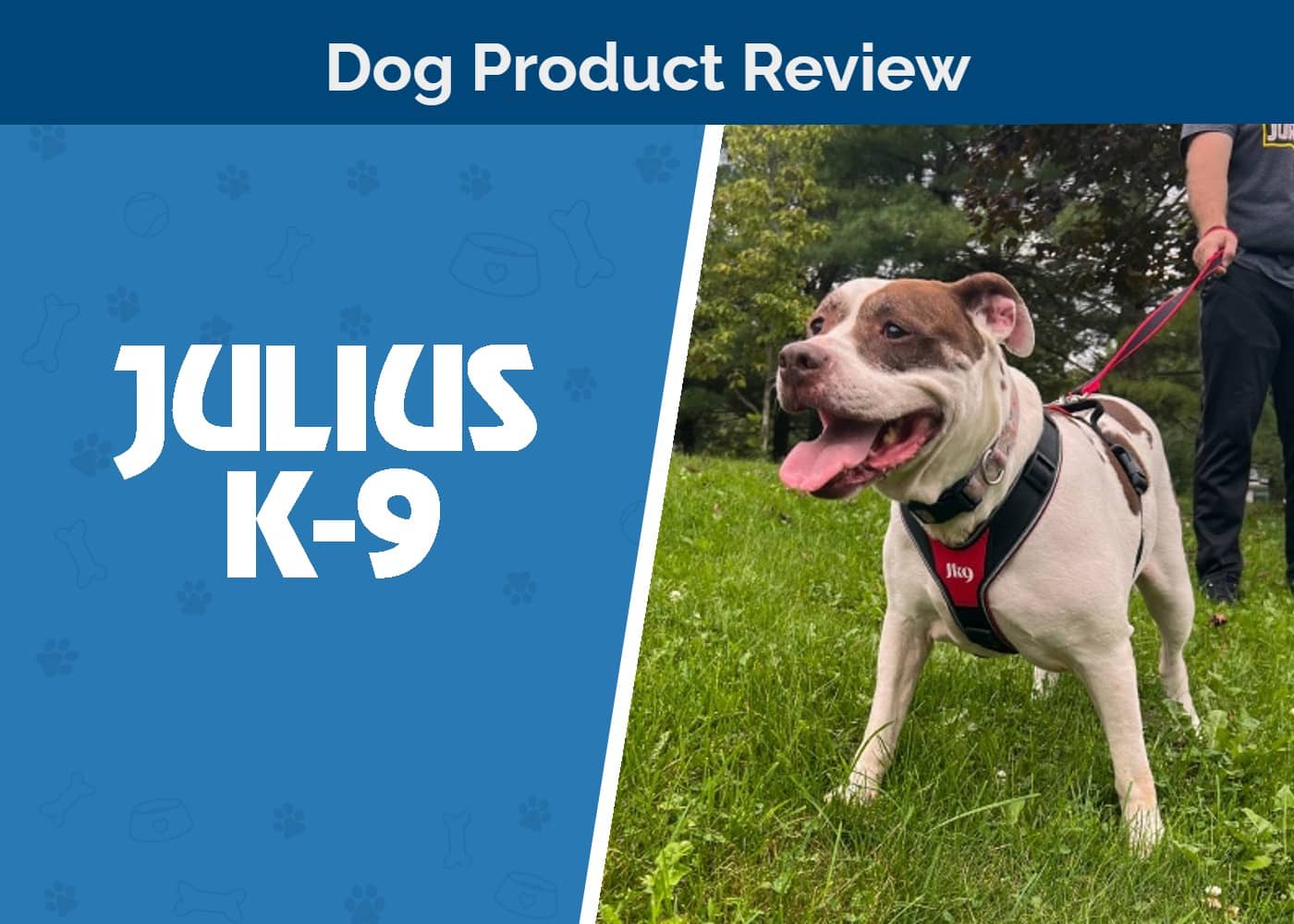Raw Dog Food vs. Kibble: The Main Differences

Updated on
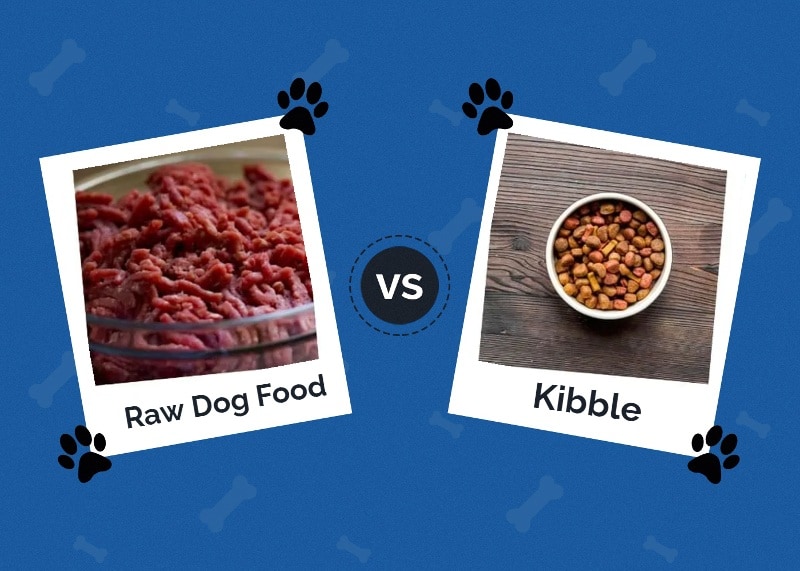
Click to Skip Ahead
When you consider all the dog food options out there, choosing the right diet for your dog can be daunting. Raw dog food and kibble are two popular options when it comes to feeding your dog, and they both have a lengthy list of pros and cons.
Raw dog food is appealing to many dog owners for the simple fact that you can make it at home. This way, you know exactly what your dog is eating. However, raw diets are also easy to mess up if you don’t pay close attention to sanitation regarding the raw meat contents or adhere to your dog’s nutritional requirements.
Compared to preparing raw diets, kibble is a simpler option. It’s ready to serve and has a long shelf-life that enables you to go longer between restocking your dog food. But many people are concerned by exactly how, and from what, the dog food is made.
Both options can be good for your dog, depending on their needs. This guide will compare the pros and cons of raw dog food and kibble to help you choose which option is the best for you.
At a Glance
- Can be commercial, dehydrated, freeze-dried, or homemade
- Claims to promote dental health
- Claims to provides natural nutrition
- Raw meat content can be risky around children or the immuno-compromised
- Recommended that a veterinary nutritionist has been involved in formulation
- Claims to promote dental health
- Long shelf life
- Ready to serve
- Commercially made, usually in large scale
- Nutritional and ingredient content is available on the label
Overview of Raw Dog Food
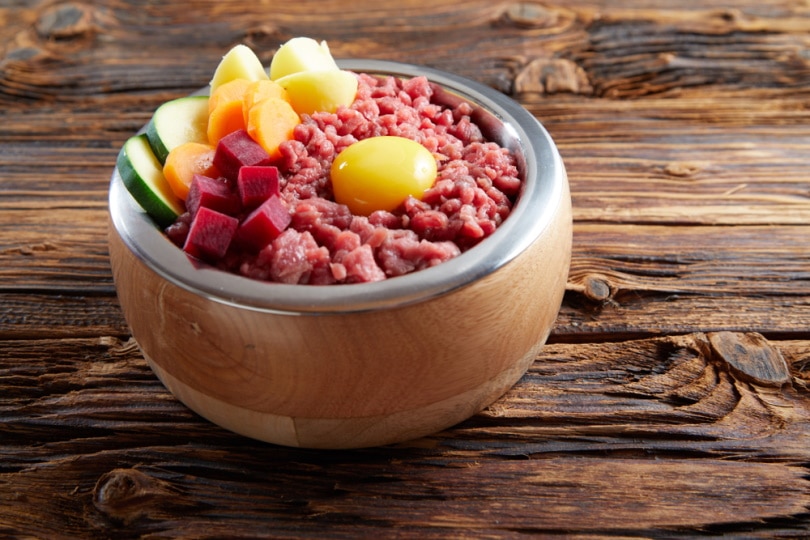
Designed to mimic the diets of dogs before they were domesticated, raw dog food consists of raw meat such as muscle, bones, and organs. It’s available in dehydrated or freeze-dried forms and can be bought from most online retailers and physical stores or made at home.
Benefits of Raw Dog Food
The best part about raw dog food is the fact that there is no cooking required. This keeps the natural nutrients and flavor intact. These are what proponents say make raw diets so healthy for dogs, with benefits claimed for their skin and coat health, immunity, and overall welfare.
Dangers of Raw Dog Food
Despite its positives, raw diets aren’t easy to get right, especially if you make your dog food at home. It can be incredibly easy to throw many ingredients together to make a fancy meal while completely missing the nutrients that your dog needs.
Along with the time that it takes to make raw dog food at home, you also have to factor in the cost of a veterinary nutritionist who can help you understand and meet your dog’s nutritional needs. There’s also the risk involved in handling raw meat and the harmful bacteria and parasites that it can contain.
- Ingredients retain their natural vitamins and minerals
- Retains natural flavor
- Claims to promote skin and coat health
- Can be dehydrated, freeze-dried, homemade, or store-bought
- Customisable to your dogs preferences and needs
- Short shelf life
- Needs to be kept refrigerated
- Ingredients can be expensive
- Requires research into canine-appropriate nutrition
- Higher risk of harmful bacteria
Overview of Kibble
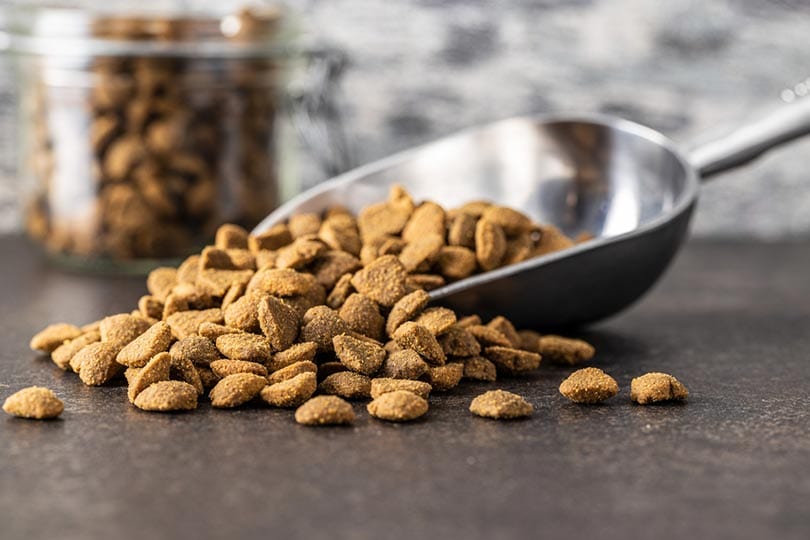
The most popular form of commercially made dog food is kibble, or dry food. It was originally introduced as an alternative to meat-based dog food during the Great Depression due to how expensive meat was. Since then, it has become the easiest way to feed dogs. While it started as mostly plant based, most brands these days use meat in their recipes.
Benefits of Kibble
Kibble is designed to be a convenient way to feed your dog. It’s easy to store and has a long shelf life when unopened. The pricing is quite varied depending on the brand and ingredients used.
Dangers of Kibble
Unfortunately despite regulations and testing it is still possible to have health concerns with pet food resulting in a recall. In the U.S dog kibble should meet AAFCO requirements for nutrition but it still may not be clear on the origin of the ingredients.
- Claims to promote dental hygiene
- Multiple bag sizes are available
- Generally more affordable
- No preparation necessary
- Scientifically formulated to supply dogs with the right nutrition
- Needs to be stored in a cool, dry place
- Low moisture content
- Not customisable to each pet
- Product recalls can happen
What Are the Differences Between Them?
Side by side, the differences between raw dog food and kibble are more apparent and can help you decide which option is the best for you and your dog. Here are a few of the biggest factors to consider when it comes to the type of diet for your dog.
Cost
- Edge: Kibble
High-quality, nutritionally balanced dog food is always expensive, but even high-end kibble is generally cheaper than raw dog food. Kibble often comes in a range of bag sizes, from a few pounds to 30- or 40-pound bags. The larger bags can be a strain on your finances, but you also won’t need to stock up for a while.
Conversely, many people make raw dog food at home. In this case, you have to consider the cost of everything that goes into making the raw food and ensuring that it’s healthy for your dog. Quality meat is expensive, and buying in bulk is often the best way to prepare your dog’s meals. There’s also the short shelf life of the meat you use and the cost of hiring a veterinarian nutritionist to make sure your dog’s diet is suitable.
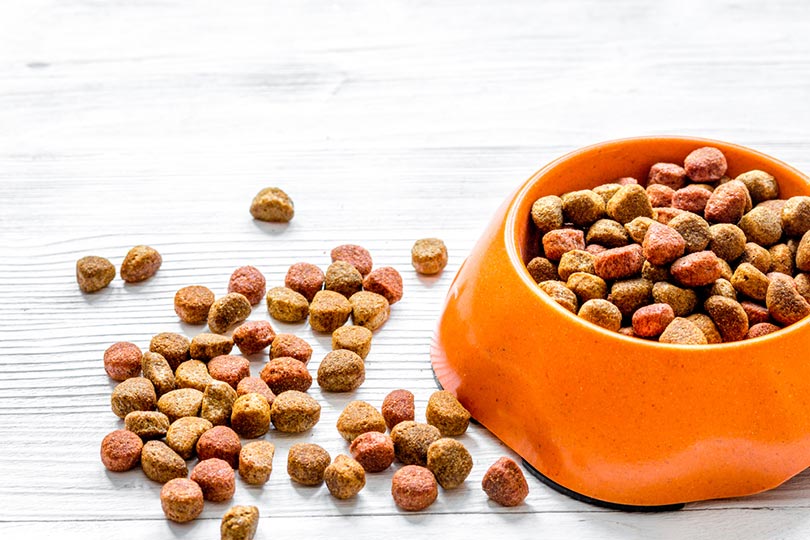
Flavor
- Edge: Raw dog food
When it comes to flavor, raw dog food anecdotally wins by a landslide. There are many stories from happy pet parents who say their dogs are now eating with more gusto than when they were fed kibble only. Kibble contains many ingredients baked into an extruded biscuit and some natural appeal can be lost along the way.
Raw food doesn’t require cooking at all. This means all the ingredients that you use will retain their natural flavors and don’t require a boost from flavor enhancers. Many dogs generally find raw diets more appetizing than kibble.
Ease of Preparation
- Edge: Kibble
Homemade raw dog food takes a great deal of time and effort to put together. Before you even begin making the meals, you’ll need to research the nutritional requirements that your dog needs and perhaps hire a veterinary nutritionist to tailor the nutrition to your dog (or dogs, if you have more than one).
Once the research is done, you have to purchase and then prepare the ingredients. You also must pay attention to hygiene when it comes to handling raw meat products. This doesn’t just apply to preparing the meals either. You’ll have to clean up the utensils that you used when you’re done and even clean your dog’s bowl after they’ve finished eating to prevent harmful bacteria from affecting future meals.
In comparison, kibble is a simple “scoop and serve” deal that saves a great deal of time and energy, especially if you’re in a rush.
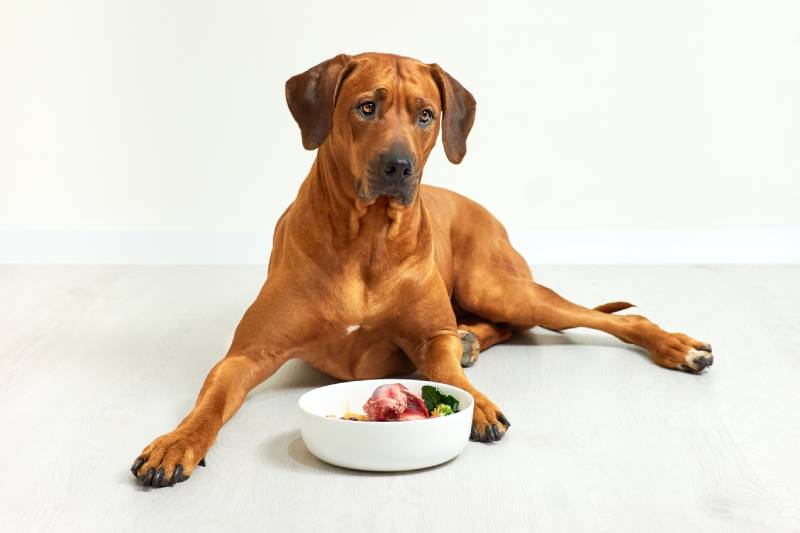
Nutritional Value
- Edge: Not known
While kibble manufactures often have teams of scientists working on the formulation and testing of foods there is less consistency in the raw food brands. There are currently no studies proving that one is better than the other. Advocates of raw feeding say that vitamins and minerals may be lost in the processing of kibble and that raw food is more nutritious. This is one we will leave to the animal nutritionists and scientists to advise.
There is a caveat, however. Raw dog food is more likely to be dangerous for your dog if you don’t pay special attention to their nutritional requirements. If you don’t have time to properly prepare balanced meals or research the nutrition that your dog needs and how to supply it in their diet, high-quality kibble will be a better option.
Shelf Life
- Edge: Kibble
Raw dog food might be packed full of flavor and nutrition, but it also relies on the shelf-life of the meat used in the recipe. This is one of the biggest downsides when it comes to this type of diet for your dog, especially if you forget to put it back in the fridge when you’re finished with it.
Kibble can be stored for up to 2 years if you haven’t opened it. It doesn’t have quite as long of a shelf life when opened, though, and many of the bags aren’t resealable to help retain freshness. If you do have enough space, you can invest in a sealable container to keep the kibble in so you can store it for longer.
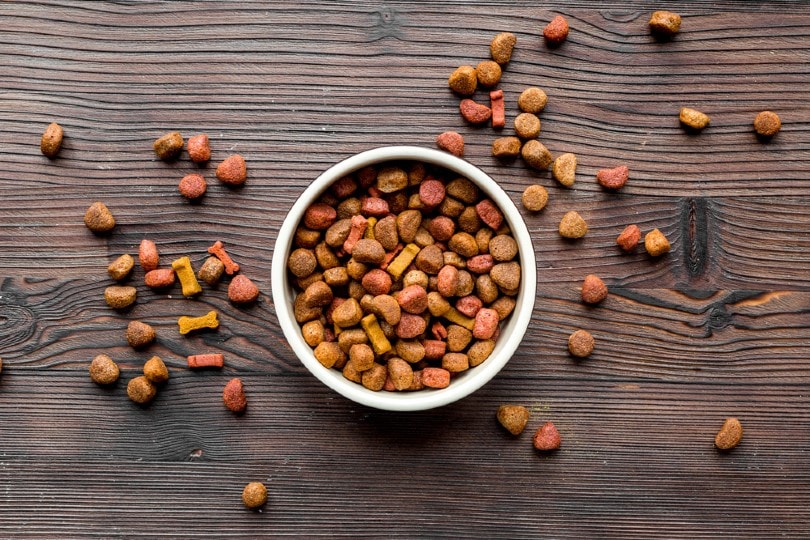
Storage
- Edge: Tie
It’s hard to say which food is better when it comes to storage options, so this one’s a tie. Both raw diets and kibble can be inconvenient when it comes to storing them.
Raw dog food needs to be kept in the refrigerator due to the meat content. If you have a large household already, finding space for your dog’s food can be a challenge. Homemade dog food also requires finding space for all the ingredients. If you buy the meat in bulk, you’ll need to freeze it until you’re ready to use it.
As for kibble, small bags can be more suitable for apartments, but you will have to buy food more often. Large bags, on the other hand, are heavy and difficult to find space for, especially if you have other pets that might rip the bags apart to steal the contents.
Conclusion
Raw diets and kibble both have their pros and cons. While raw diets are filled with nutrition and flavor, they also require much more preparation time and can be dangerous for you and your dog if handled incorrectly.
Conversely, kibble is ready-made and super quick to prepare for your dog. However, some ready-to-go formulas rely on ingredients or processing that you would not choose for your dog to eat.
For many dog owners, high-quality kibble formulas are more suitable when it comes to time constraints, storage space, and budget. There is an equally dedicated and increasing number of pet guardians switching to raw feeding. The choice is yours.
Featured Image Credit: (L) Jumpstory | (R) 279photo Studio, Shutterstock


